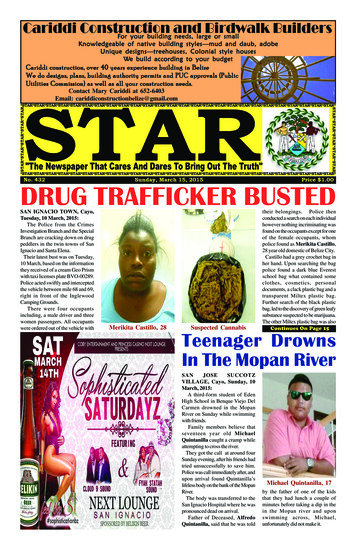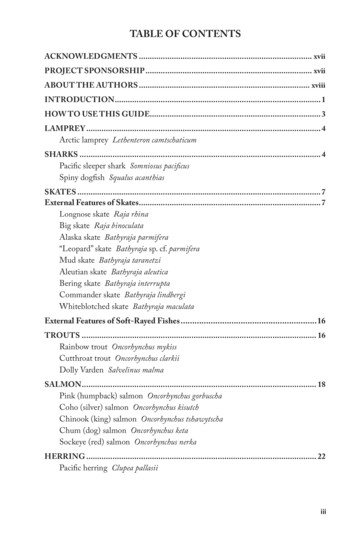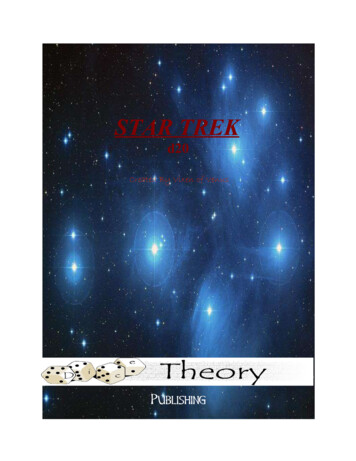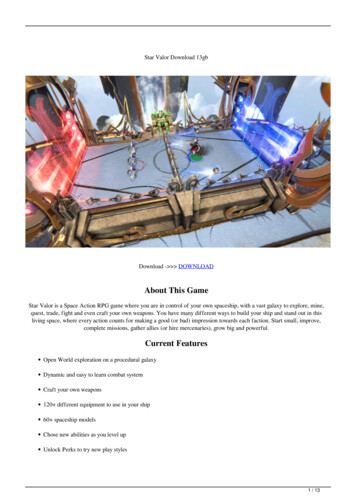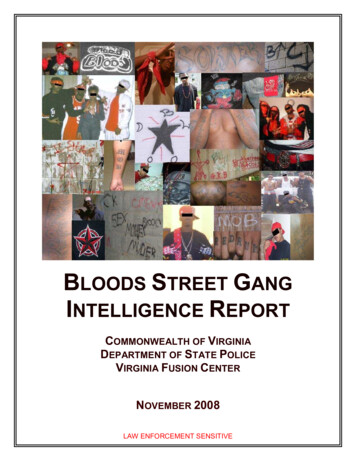
Transcription
Robin Blaser
Stan PerskyRobin BlaserBrian FawcettVancouverNew Star Books2010
new star books ltd .107 – 3477 Commercial Street Vancouver, BC v5n 4e81574 Gulf Road, #1517 Point Roberts, WA 98281 usawww.NewStarBooks.com info@NewStarBooks.comcanada“Reading Robin Blaser” copyright Stan Persky 2005, 2010. “Robin AndMe; The New American Poetry And Us” copyright Brian Fawcett 2010. Allrights reserved. No part of this work may be reproduced, stored in a retrievalsystem or transmitted, in any form or by any means, without the priorwritten consent of the publisher or a licence from the Canadian CopyrightLicensing Agency (Access Copyright).The publisher acknowledges the financial support of the Canada Council,the Government of Canada through the Book Publishing IndustryDevelopment Program, the British Columbia Arts Council, and theGovernment of British Columbia through the Book Publishing InvestmentTax Credit.Cover by Mutasis.comCover photo courtesy David FarwellElectronic edition published May 2010library and archives canada cataloguing in publicationPersky, Stan, 1941–Robin Blaser / Stan Persky and Brian Fawcett.ISBN 978-1-55420-052-81. Blaser, Robin — Criticism and interpretation. 2. Blaser, Robin —Friends and associates. I. Fawcett, Brian, 1944– II. Title.PS8553.L39Z86 2010 C811'.54 C2010-901736-6
ContentsReading Robin Blaser by Stan Persky3Robin (some photographs)46Robin And Me; The New American Poetry and Usby Brian Fawcett63
Robin Blaser
Reading Robin Blaserby Stan Persky1My first encounter with Robin Blaser’s poetry was in 1960. I wasa nineteen-year-old sailor stationed at the American naval airbase at Capodichino, Italy, just outside Naples. Harold and DoraDull, a couple from the San Francisco poetry scene, whom I’dmet the year before at Sunday afternoon poets’ meetings there,had arrived for a sojourn in Europe and were staying in a smallfishing village, Amalfitano, along the Amalfi coast just south ofthe bay of Naples. On Friday afternoons, I left the military baseand took the bus from Naples to spend the weekend with them.Later, in easy stages, they made their way north, to Rome, Florence, Paris, with me tagging along in their wake, and eventuallythey temporarily settled on the island of Ibiza, where Dora gavebirth to twin girls.Harold and Dora were six or seven years older than me, oldenough for me to adopt them as putative modernist parents orelder siblings. They introduced me to music, paintings, museums,churches, books, thought — in short, civilization — in all theplaces I visited them. Amalfitano, on the Mediterranean Sea,consisted of narrow lanes and jumbled houses clinging to the ver
stan perskytiginous cliffs just back of the beaches, where fishermen mendedtheir nets and sorted the catch.The first weekend I arrived at the eyrie they’d rented abovethe sea, Harold handed me a copy of a recently written poemthat he’d brought from San Francisco. It was by Robin Blaser, aSan Francisco poet who had been living in Boston and workingas a librarian at Harvard, and whom I knew of only from talkin San Francisco that placed him as one of a literary threesomethat included Jack Spicer and Robert Duncan. They had all beenclassmates at the University of California in Berkeley at the endof World War II. The poem Harold handed me was called Cupsand was Blaser’s first “serial” poem, the form Jack Spicer hadinvented a couple of years earlier in his book After Lorca.Almost immediately, Blaser introduces one of the poem’s greatthemes, the nature of art made in oppositional friendship:There were two.Their posturetaken out of the wallpaper (a ghost story)Jack talked. Hisdetermined privacy againstMy public face. The poemby dictation. . . .The relationship of the “two” is encoded in a kind of shorthand, bearing traces and notations of private biographical references, such as the wallpaper at a communal house where theyhad lived as students, but there’s an immediate opposition intheir “posture.” One’s “determined privacy” against the other’s“public face” is resolved, however, in the agreement on “The
Reading Robin Blaserpoem / by dictation.” The idea is that the poem is transmittedfrom some unidentified outside source through the poet, andalthough it makes use of the poet’s own vocabulary, biographicaldetails, etc. (what Spicer called “the furniture in the room”), thepoet is not permitted to interfere with the “dictation.” Whetherthis theory of poetry is true, I quickly learned, matters less thanthe fact that Spicer and Blaser used it as their working procedure,as their “myth.”The first poem of Cups, like most of the succeeding ones in theserial, ends in a semi-rhymed, musical language:The clown of dignity sits in a tree.The clown of games hangs there too.Which is which or where they go —the point is to make others seethat two men in a tree is clearlythe same thing as poetry.The two men are Jack Spicer and Blaser himself, and the poemtraces the narrative of their art, as they appear in their respective,characteristic guises, Blaser with his notion of dignity, Spicerwith his love of games, both of them clowns, but more importantly, both of them in the tree, which is “clearly / the same thingas poetry.”The other themes of Cups, the title of which refers to one ofthe suits in a pack of Tarot cards, include the shifting figure ofAmor, under whose sign the poets work, as well as erotic desireitself, and the scenes of Blaser’s boyhood, the arid landscapesof rural Idaho in the 1930s, with its sere gullies and desolaterailroad tracks, which provide the sources of Blaser’s amorousvocabulary.
stan perskyThe two poets both fall down, as poets are prone to do, “intothe clover where love abounds,” tangled in their imaginings.There, they gather a poem made of four leaves:1 for the lip of Amor’s crown.1 for the tree they ran around.1 for the bed where they lay down.1 for the comical physical uniontheir arms like briarswrapped around.In Blaser’s poetry, characteristically, some sight from the mundane world is seen as a “marvel” or some object is looked intountil it spills out: “This / time I saw the god / offer with outstretched hand / the heart to be devoured. The / lake flowedinto my hands. / Dante would say the lake / of the heart.” Butthroughout, the ballad-like passages, reminiscent of rhymes ina children’s book, are subverted by an unsentimental realism.The romance of desire becomes the “comical physical union” ofactual sex. Our behaviour, as poets and lovers, is farcical: “Twomen sit in a tree / and wink and spit.” Yet “. . . this is the tree /where Amor sits,” and it is gift-giving Amor who lays down the“rules” of the game.One imagined two small windowscut in his skin. His breastslook out upon the tree.The other thought the shapeof his tongue was poetry.The word, he saiddrawn like an arrow,
Reading Robin Blaserso fitsinto the body of the bird it hits.Both the landscape and memory of Blaser’s childhood emergefrom the metric narrative. The “shadow of the sagebrush / turnsthe hill blue . . .”, the tree itself speaks, and Robin’s Uncle Mitchwrites Westerns and whistles between fragmented sentences,invoking an older history of the American frontier, its aboriginalinhabitants, and the rider-scout-guide “who leads us out.” In thesexual darkness of youth there is the “effort to untie the strings /of the loins. The lips endure / the semen of strangers.” Althoughthe poem assumes homoeroticism, it doesn’t insist on sexual preference. More important is the relation between Amor, the body,and poetry. “Where Amor sits,” the poem says, “the body renewsitself, / twists / inhabits the rights of poetry.” Throughout it all:Two men sit in a tree.How ugly they arein the bright eyeof this pageantry.In service to loveis dignity, one cried,1, 2, 3, the other replied,you’re outwhen the dew falls from imagination’s dark.Amor turned geometer,briefly, of course,and cut their bodies into triangular parts.When reassembledthey hung in that tree,
stan perskytheir genitals placedwhere their heads should be.If poetry is the “pageantry,” the poets are ugly, which is to say,merely human, as they spout their maxims about our undignified efforts to maintain our dignity in desire or recite the rule inbaseball about three strikes and you are momentarily out of thegame. For their trouble, the self-deceptions of desire leave themwith their genitals placed “where their heads should be.” Imagesof incestuous desire, sexual mutilation, and jokes about bestialityand the like, all of which turn up in Cups, are the turnings backand forth of language and desire. It would be a mistake to readthem as perversity for its own sake; rather, they reflect the literalperversity or turnings of desire. The children’s rhymes functionas metamorphoses: so, “The dew fell from imagination’s dark /on to our hands where it stuck like bark,” and later,What falls from the treerenews itself in the guiseof poetry.The guiderides out of the darkwith a body shapedfrom the sluffing bark.I’d learned to “read” poetry only the year before, at the poets’Sunday afternoon meetings in San Francisco presided over bymy teacher, Jack Spicer. Through listening to and observingwhat excited the poets’ interest, I quickly got an idea of whatpoetry was about, and soon I was writing some poems of myown. Now, above the Mediterranean, with Harold and Dora
Reading Robin Blasersharing my pleasure, I immediately recognized Blaser’s shapeshifting poem about the intersections of myth and memory, ofpoetry and desire.Cups may have initiated my interest in Dante, or perhaps Ifound the Italian master through Harold, who had considerablefacility with language and was learning to read the fourteenthcentury poet’s Commedia in the original. In any case, I, too,soon encountered Dante’s lago del cor, “the lake of the heart”that appeared in Blaser’s Cups. But thinking of the fishermen atAmalfitano, I wrote,It was not the lake of the heartit was the loadtaken from the seaand the seen is not enoughto know the poetry. For thatyou have to gointo the poet’s countrywhich is a darkling wood . . .thus echoing, as so many poets have, Dante’s mi retrovai in unaselva oscura (”I found myself in a dark wood”) in the first cantoof The Inferno.2When I returned to San Francisco in January 1962, I found JackSpicer sitting on a barstool at Gino and Carlo’s on Green Streetin North Beach, and brought him my poem, “Lake,” upon whichhe promptly placed his imprimatur. He shyly clapped me on theback and proclaimed it “the best poem anyone around here has
stan perskywritten in two years,” a double-edged compliment in that it wasalso meant to chastise those poets who had been lazing about notwriting the best poem in the last two years. Though I was pleasedby my master’s approval, sitting in the half-deserted bar on achilly January night, it looked like a long winter ahead.Spicer mentioned that Robin Blaser was in town, back fromBoston. As much to relieve Spicer’s boredom and to forestall hiscomplaints that “no one was coming around to the bar,” I suggested that we call Blaser up and get him to join us in Gino’s.“Oh no, Robin never comes out to the bar,” Spicer groused.“He will if I call him,” the arrogance of youth replied.Spicer bet me a quarter I couldn’t get Blaser down to the bar,and even supplied me with the nickel for the telephone call.“Hi,” I said to Blaser, giving my name and announcing, “I’mtwenty-one years old, I’ve just come back from the Navy, and I’mhere in Gino’s with Jack Spicer. Jack says you don’t come out tothe bar, but I told him he’s wrong. So why don’t you come downhere and have a drink with us like a regular guy?” Utterly shameless. But what does youth have to trade on but youth? That, andthe fact that, after all, “regular guys” got together for drinks,didn’t they?In about half an hour Blaser appeared in the doorway of Gino’s.Jack paid off his bet, which he no doubt considered a bargain,given the entertainment value of having Blaser in the bar. For hispart, Blaser acted as though, on the one hand, he’d been invitedto a chic cocktail party which he was longing to attend, and onthe other, that having a drink in Gino’s is what regular guys didall the time.Blaser was a trim man, in his mid-thirties, with an aquilinenose, high cheekbones, and a careful brush-cut. He was oneof those people who, while gawky as a youth, becomes strik10
Reading Robin Blaseringly handsome as an adult, and distinguished-looking as anelder. There was a slightly fey edge to him, but it was unlikethat of full-fledged homosexual queens I’d met who enacted thewounded bitterness found in much of camp behaviour. Blaser’smanner derived from an older connection to the world of faerie,as he called it in a subsequent poem he’d written that played onEdmund Spenser’s Faerie Queene. In any case, Spicer had thesatisfaction of an entertaining evening in an otherwise desolatebar, I got to meet the author of Cups, and we had our drinks.Blaser walked me home.I’m now going to explicitly intervene here for one paragraph.Blaser and I soon began a relationship, and we lived togetherfor about five years, eventually moving from San Francisco toVancouver in 1966, the year after Spicer’s death, where Blaserbecame a professor at Simon Fraser University. I intend to drawthe proverbial curtain around our private life, treating it as simply that, private. I have no intimate and/or scandalous gossip toretail here. If there are any personal details to reveal, they’ll berelevant to my main subject, Blaser’s poetry. I can say of my partof the relationship that I was often thoughtless in the way peoplein their twenties can be, but didn’t cause, I don’t think, any lasting damage. More important, more than forty years later, Blaserand I were still intimate friends, who happened to live less thana block from each other in Vancouver. In various book inscriptions, dedications, and notes from him, I’m always regarded as acompanion du voyage, attended by “love, of course.”What remains, from the clutter of the personal and the ordersof the places where we lived, are the poems. While I wouldturn out to be something of a loner, Blaser was by temperamentinclined toward the domestic. His ideal working condition asa poet included the rustle of the other person, or even the roar11
stan perskyof the televised crowd as I sprawled in the next room watching a Sunday afternoon football game, while he “fumed,” as hedescribed it, over a poem at the book-cluttered kitchen table.Both the companion and the house — a series of apartments andhouses, on Baker Street, Bernal Heights, and Allen Street in SanFrancisco, and on 1st Avenue, then Trafalgar Street in Vancouver — were central to his way of life. While my basic mode ofhabitation is the more or less anonymous hotel room, somethingclose to Jack Spicer’s shabby rented rooms, Blaser introduced meto the magic of the household.As visitors to all of Blaser’s domiciles immediately remarked,sometimes jokingly referring to them as a “museum,” the housefor him was an order of objects, art, furniture, carpets, books,each deliberately chosen and arranged, so that their inter-relations set up a sort of field of activity. The old notion of householdgods was treated literally.The house is connected to the outside by way of the garden,whose trees and flowers Blaser tended, and from which he broughtRobin Blaser andStan Persky, StinsonBeach, north of SanFrancisco, 1963.Photographer: HelenAdam, CourtesyDavid Farwell12
Reading Robin Blaserinto the house buds of willow, blue irises, branches of pepper treeand other blossoms that appear in his work. In one poem, Blaserrefers to a blue bottle in the shape of a goddess, into whose openhead he inserted a stalk of daphne one day. The unmistakeablesweet scent of the daphne plant had filled the house by the timewe returned late that night, an event which Blaser reads in apoem as “giving power” over the house to the goddess. Again,whether or not such magic is “true” in a conventional sense, itshould, like “the poem / by dictation,” be regarded as a workingprocedure.Finally, beyond the garden, which is the domestic representation of nature or a larger entity Blaser called “the holy forest,”there is the city. With its buildings looming out of the fog of SanFrancisco, or its downtown towers perched on a peninsula amidthe “burning water” of Burrard Inlet of Vancouver, the “city”is connected to notions of community and the public realm,the “political” themes of Blaser’s poetry. The actual city is shadowed by the historical notion of the Greek polis, an urban spacedefined by the active engagement of its polites or citizens. In fact,all of these — house, garden and city, sometimes the whole of ita holy forest — have to be seen as both specifics and categories inBlaser’s ordering of the world.But it was a strange event in the house that began Blaser’sMoth Poem. One day in 1962, in his Baker Street apartment, heheard an eerie sound emanating from the baby grand piano, asif the instrument itself was playing. When he lifted the lid of thepiano, he discovered the source of the sound, a moth trappedin the piano strings. The moth was duly rescued and the poembegan. Once the first moth appeared, so did others, over a year ormore, inexplicably turning up in the most unexpected ways, to13
stan perskyprovide the images or metaphors upon which successive poemsin the serial were predicated.If the appearances of the moths were a kind of “magic,” asSpicer and Blaser used that term, nonetheless, Blaser insisted onidentifying himself as a “literalist,” as the titles of the first twopoems in the series put it. That is, it really happened.the moth in the pianowill play onfrightened wings brushthe wired interiorof that machineI said, ‘master’One of the differences between poetry and prose is that thelines of poetry function as “doubles,” bearing the meaning contained in the line — the moth in the piano “will play on,” thatis, will continue to play, whether one reads the moth as simplya literal creature or a representation of the poet — as well as themeanings extended by succeeding lines — the moth in the piano“will play on / frightened wings.” And “frightened wings brush/ the wired interior / of that machine.” This fleeting reminder ofwhy poems have linebreaks is the most fundamental element ofthe art, yet it’s a point seldom made in schools, leaving studentspuzzled about how the poem tells multiple stories.The story of “The Moth Poem” is of a man and his episodicencounters with the ephemeral meaning of the world, embodiedin the figure of moths. At its core is the narrative of the “medium” in a world of language, moth-wings, house, holy forest, andthe politics of the city. Blaser says in “The Medium,”14
Reading Robin Blaserit is essentially reluctance the languagea darkness, a friendship, tying to the realbut it is unrealthe clarity desired, a wish for true sight,all tangling‘you’ tried me, the everyday whichcaught me, turning the housein the wind, a lovecraft the politicalwas not my business I could not lookwithout seeing the decay, the shit pouredon most things, by indifference, the personalpower which is simply that . . .Poetry’s language, Blaser asserts, is essentially a “reluctance,”the art of it is neither easy nor simple. The language is a “darkness,” yet it is also a “friendship,” tying us to the “real” world,but as throughout this dialectic of assertion and denial, the realis also “unreal.” The desire for clarity and “true sight” is tangled,and we are “tried,” tested, by the forces, both literal and metaphoric, that shape our lives. Here, Blaser makes one of his firstuses of a pronomial figure, the second person singular placed insingle quote-marks, ‘you,’ which will reappear throughout hislife’s work. While the word you (without quotes) is used in conventional ways to address another person or to reflexively referto oneself, ‘you’ in single quotes becomes a god or spirit of otherness. Like other figures in Blaser’s poetry, ‘you’ is a shape-shift15
stan perskying entity, whose apparitions range from simply the other person in the sense of his or her separateness from ourselves, to anembodied figure in one of Blaser’s late works, an opera librettocalled The Last Supper (2000), where the ‘you’ is a woman who isthe ghost of the twentieth century addressing the audience:I am the ghost of you,of your century,of your courage,in the fragmentsof our paradiseI can see myself in your eyes.While Blaser is a poet who envisions a fragmented paradise,embodied in the marvels of literal objects and events, this possibility is consistently juxtaposed against the actual politicalworld. Although he declares it not his business, he nonethelessconfesses, “I could not look / / without seeing the decay, the shitpoured / on most things, by indifference, the personal / / powerwhich is simply that.” Or as the ghost says to the public of TheLast Supper, “. . . each of us, / a bare thing, swims / against thebrutality and terror / of our century.” Although Blaser’s poetry isremarkable for its beauty, even its “poetical” qualities, the magicof the real always appears within the context of a twentieth century of war, genocide, and exclusions. It is not at all inconsistent when the Christ in Blaser’s libretto declares, “The Holocaustshattered my heart,” offering the naked apology that the RomanCatholic Church, which claims to operate in Christ’s name, wasunable to pronounce, even a half-century after the murder ofEuropean Jewry.“The Medium” was written one weekend while we were stay16
Reading Robin Blasering at a friend’s summer cabin on the Russian River, north of SanFrancisco. That night, says the poem,. . . I sleptin a fire on my book bag, one dried wingof a white moth the story is of a manwho lost his way in the holy wood“Lost,” the poem says, “because the way had never been takenwithout / at least two friends, one on each side,” an oblique reference to Spicer and Robert Duncan, their long friendship nowstrained by quarrels over poetry and flare-ups of personality.Friendship gone astray, so that Blaser is. . . now left to acknowledgehe can’t breathe, the darkness bledthe white wing, one of the bodyof the moth that moved him, of the otherwing, the language is bereftRepeatedly, in a poem that argues that art and intelligence areas perilous as the lives of moths, these creatures reappear, tapping against a window with the sound of “it it it it,” and evoking immediate scenes as well as a childhood past replete withremembered grandmothers. As a moth “tacked with the wind’schanges, / careened, then, taking flight, hid / in the fig tree”of the garden, it is encircled by the larger cosmos, “the moon,the stars, the / planets and below, under the earth”; equally, thesound of the moth in the piano becomes “a tone / beyond that,17
stan perskythe lyre,” until the mind of the poet-priest is “nearly destroyedby the presences, the fine / points which have no beginning.” Themoments caught by “The Moth Poem” are precise miniatures,the poems of modest size, but the poetry is large.At the end, in a sort of epilogue called “The Translator: ATale,” Blaser is translating Catullus’ “Attis” one morning. Henotices thatlast night’s coffee spoon sticks to the drainboardunder it the clear print of a brown moth, made of sugar,cream, coffee with chicory, and a Mexican spoon of blueand white enamelThe ashtray is full and should be emptied before workingthat translation, Attis ran to the wooded pastures . . .Instead, the ashtray is neglected while the poet translates fromthe Latin of Catullus’ gender-shifting poem, only to produce afinal epiphany:the mound of cigarette butts moves, the ashes shift,fall back on themselves like sand, startle out ofthe ashes, awakened by my burning cigarette, abrown moth noses its way, takes flight3Even as he was concluding “The Moth Poem” with a last magicalappearance of a moth rising from the full ashtray, a virtual phoenix, Blaser had already embarked upon a new, but different kindof serial poem. Image-Nations, the first of which were written inthe midst of the previous composition, is an intermittent, rather18
Reading Robin Blaserthan consecutive poem, one that would continue, concurrentwith other poems, over the next three and a half decades. Thiskind of serial poem was not without its precursors in San Francisco. In Robert Duncan’s book, The Opening of the Field, whichhad appeared in 1960, a similar serial, “The Structure of Rime,”begins with eloquent bravado:I ask the unyielding Sentence that shows Itself forthin the language as I make it,Speak! For I name myself your master,who come toserve.Writing is first a search inobedience.For all the disputes of local friendship — the bitchiness, bitter gossip, the “feuds” — the San Francisco poets of the early1960s were indisputably engaged in a community of poetry. Ifthe poems within a given serial poem resonated against eachother, it can be equally said that the poems and books, the workof various poets — Duncan, Blaser, Spicer, but others such asGeorge Stanley, Harold Dull, Joanne Kyger and Ebbe Borregaard as well — also resonated with and against each other inthis West Coast city that was easily seen as a double-city. Therewas the visible one whose streets, hills, and business canyons wewalked, and the invisible city that bound us both to contemporary poets across the country — Charles Olson, Robert Creeley,Allen Ginsberg, Frank O’Hara and others — who were part ofthe “New American Poetry,” as well as across time, to poets invarious lineages of a tradition that extended back from the pre19
stan perskyceding generation of modernists to the first bards.In a 1968 essay, “The Fire,” Blaser expounded upon the SanFrancisco variant of this poetry. “I’m interested in a particularkind of narrative,” he says, what Spicer and he had agreed to callthe serial poem, “a narrative which refuses to adopt an imposedstory line, and completes itself only in the sequence of poems, if,in fact, a reader insists upon a definition of completion which isseparate from the activity of the poems themselves. The poemstend to act as a sequence of energies which run out when so muchof a tale is told.” Blaser describes this “in Ovidean terms, as acarmen perpetuum, a continuous song in which the fragmentedsubject matter is only apparently disconnected.” Ovid’s words, asBlaser cites them in his own translation, areto tell of bodiestransformedinto new shapesyou gods, whose powerworked all transformations,helped the poet’s breathing,lead my continuous songfrom the beginning to the present worldThe reason for spelling all this out, about Blaser, Spicer andothers, in considerable detail, is that this discussion ought tobe construed as an attempted rescue or defense of poetry. Noneof this account would make much sense unless I believed, as Ido, that poetry is a mode of experience in the world that cannot be subsumed by the other modes of language, namely, story,discourse, and the mathematical languages of science. Because,at the beginning of the twenty-first century, poetry has been20
Reading Robin Blaserutterly “marginalized” in the culture in which I live, it becomesimperative to leave future readers, if there are any, with at leastan echo of an indispensable experience which the present forcesof the world would dispense with and erase. There is nothingoutside ourselves to mandate the existence of a mode of experience, especially under conditions of the decreasing communicability of that experience, and in a world where the value of suchexperience has been debased. So, poetry can be lost, and if notyet lost, is imperilled.Blaser’s Image-Nations, which obviously play on the notionof “imagination” while demarcating its visual and political elements as “image-nations,” begin with a sense of such peril, whenhe declares, “the participation is broken”:that matter of language caughtin the fact so that wemeet in paradise in suchtimes, the I consumes itselfThe relation of language and poet is conceived as a “participation,” a meeting in paradise, yet language is “caught / in thefact,” that is, its daily usage in the world. Even from this earlypoint in Blaser’s poetry, the authorial “I” and related notions ofthe self are challenged as a given idea. The “I” is not merely afirst-person voice providing autobiographical anecdotes, but anuncertain nexus in a process of construction and dissolution. Inasking how the broken participation might be restored, Blaserturns to the story of the household cat giving birth to four kittens on the bed. “When they are there / she comes to his feet,”he writes,21
stan perskypicked up and held, shefills his hand with bloodthe red pool flows overhis silver ring, dripsto the floorThe bloody birth and the broken participation between language and poet converge in the poem’s resolution:the language sticks tohis honey-breath she isthe path of a tale, a doorto the perishing moonshine,holes of intelligencesupposed to be in the heartThe birth blood that drips to the floor becomes the languagethat sticks to the poet’s “honey-breath,” while the story of themarvel of birth transforms the household cat into “the path ofa tale, a door” leading to the “holes of intelligence . . . in theheart.” Although subsequent Image-Nations will enter morecomplex and difficult structures of meaning, the first poems ofthis series retain the guise of children’s tales, albeit for adults,given the density of thought, and a narrative that defies prosaicparaphrase.With Image-Nations underway, and “The Moth Poem” completed, Blaser embarked on a project of translation, the creationof an English-language version of the nineteenth century mystical poet Gérard de Nerval’s Les Chimères. At the centre of thispoem, whose eponymous metaphor of apparitional appearanceswould have a natural affinity for Blaser, is a several part poem22
Reading
New Star Books 2010. new star books ltd. 107 - 3477 Commercial Street Vancouver, BC v5n 4e8 canada 1574 Gulf Road, #1517 Point Roberts, WA 98281 usa www.NewStarBooks.com info@NewStarBooks.com "Reading Robin Blaser" copyright Stan Persky 2005, 2010. "Robin And

